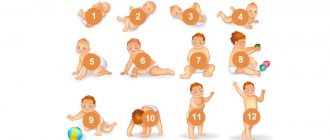What do drawing classes give a child?
The benefits of drawing have been researched and backed by science. Drawing classes develop the following qualities:
- fine motor skills, and this, as we know, is direct stimulation of those areas of the brain that are responsible for speech, visual memory, coordination;
- development of spatial thinking;
- formation of imagination;
- focus on the result that is obtained in the drawing process;
- personal expression;
- reflection of your psychological mood;
- Drawing is calming, so it is recommended for neurotic, capricious, restless children who cannot fall asleep on their own for a long time.
- development of perseverance and discipline;
- creative understanding of the world around us, understanding of another person who can see this world differently;
- development of creativity, own vision;
- promotes self-esteem because the child feels like a creator (and this is an important realization);
- development of associative and figurative thinking;
- the ability to see and feel colors, shades and palettes, generalize and compare;
- joining the world aesthetic culture.
Drawing lessons from 4 years old
As the child grows up, he already draws more complex pictures - autumn or winter, the underwater world and space, of course, based on his vision. At first, the results may turn out angular and spreading, but at 5-6 years old, children who began training at a young age usually draw such pictures well. It is very important to talk with children about their creativity - what is depicted, what characters, what they do, etc. It is necessary to keep the child’s work, this will give him confidence in the significance of his work.
A popular design for 4-5 year olds is an autumn tree or a winter Christmas tree. The technique for drawing a Christmas tree is as follows:
- make a vertical line;
- draw slightly curved lines - branches;
- outline the branches with green needles, making them fluffy;
- draw the trunk brown;
- After drying, make marks with white paint among the greenery.
It is also recommended to draw a hedgehog with your child; the work will take a maximum of 12-13 minutes. First, outline the hedgehog's body in zigzags with a pencil, then add ears, an oval with a sharp nose - the head. The paws are drawn below. Afterwards you can do more delicate work - make eyes, nose, mouth, paint the hedgehog with colored pencils and paints.
Children also love to draw owls, donkeys, cats and dogs. You can take geometric shapes as a basis, to which you can then add paws and tails. It will not be difficult to draw a person - a circle, ovals and elongated rectangles will suffice. Children from 7-10 years old, if they wish, can try themselves in portraits, still lifes and other complex drawings. If there is a need and ability, it is imperative to send the child to specialized training, where his talents will fully manifest themselves.
When to start drawing lessons
It is believed that you can start drawing with a child as early as six months, when he already knows how to sit and work with objects. Take a large sheet of paper, arrange it conveniently for drawing, take a chalk (it’s too early for a pencil, the child can pull it and get it in his eye) and draw a bright line. As a rule, the child wants to make the same one, give him a piece of chalk and let him try.
Don’t draw figures, just lines and geometric shapes of various colors, at the same time name these colors, the baby can already remember them. In the evening, show it to dad and praise the baby so that he wants to do it again. You understand, of course, that everything that happens for the first time is very important, so the first drawings need to be made bright and memorable.
From 9 months you can already move on to concrete drawing. At this age, children draw with their small hands from the shoulder, so large spaces are needed - large sheets of paper, wallpaper. It is better to start with thick felt-tip pens, then move on to pencils, pens, and thin felt-tip pens.
You need to teach your child how to use the instrument correctly the first time. This means holding with your thumb and middle finger, holding on top with your index finger. Immediately make sure that there is no overexertion of the arm or stiffness. This skill takes a long time to develop, but is consolidated for life.
At this age, the child creates chaos of lines, creates his own new world. It may seem that all this is devoid of meaning, purpose, but this is not so, there is fantasy, creativity, and self-expression in this.
You can buy finger paints, but it’s not a fact that your child won’t want to taste them. You can make such paints yourself: add different coloring juices to liquid semolina porridge - raspberry, currant, hibiscus. Pour the porridge into a bowl other than the one your baby eats from, so that there are no associations. Place a roll of the cheapest wallpaper on the floor with the reverse side, undress the baby down to his panties and let him create as much as your nerves can bear.
From the age of one and a half, the paper format can already be normal, the child begins to control the elbow and brush, and by the age of two, drawing with a brush and fingers begins. To develop this skill you need coloring books, buy them and ask them to paint small objects. Or draw something yourself, for example, a tree, and ask your child to draw leaves.
How to help a child learn to draw?
First, learn to draw for yourself. The difference between drawing a square house with four square windows and a chimney and drawing the "real" shape of the house is a huge leap in understanding. Learning to draw is more about seeing than making marks on paper.
This is very important: in order to teach your child to see this path, you must first learn about it yourself.
- Do some beginner tutorials on your own or take an art class at your local art center.
- Read Right Brain Drawing by Betty Edwards.
You must understand how an artist sees the world in order to develop that vision in your children.
✔ Don't expect instant results. The process of learning to draw is long and often measured over years, depending on the child's fine motor skills and cognitive development. Pushing a child too quickly will lead to disaster for all concerned. Gentle parenting will allow their natural talent to flourish.
✔ Learn to listen. When you look at or work with children, always be positive. When guiding their drawing, avoid correcting "mistakes" but rather make suggestions in advance.
✔ Don't impose rules. In a life that is constantly controlled by adults, art is one area of true freedom for children, so be careful to offer opportunities rather than impose rules. Be guided by their interest and abilities. When your child is happy with his efforts, praise him. If your child feels that a drawing is unsuccessful, discuss what didn't work and why it didn't work, and find some positive things to praise and learn from.
What you can discuss with children when you draw (depending on age):
- How do you feel about your drawing?
- What do you like about this color?
- Tell me about these forms.
- I love those zigzag/swirling lines.
- Do you like using a large/small brush?
- These colors are so vibrant/deep.
- This picture is interesting.
- Your drawing reminds me of... I saw something like this in a gallery.
- What a lot of attention to detail.
- You understood the subject well.
- This is a very creative approach.
How to teach a child to hold a pencil correctly
Teachers know that half of the children hold the pen incorrectly, which reduces the speed of writing and spoils their handwriting. The habit of holding a pen (pencil) is developed with the first drawings, at the same time you will teach your child to write correctly and this skill will remain for the rest of his life.
There is a fun exercise that helps you grasp a pencil correctly: take half of a napkin and ask your child to hold it with his ring and little fingers. Then give him a pen so he can grab it with his remaining three fingers. Remind that the napkin must be clamped at all times. While this is happening, the handle is held correctly. Don't be lazy to bring this to automaticity.
Step by step teaching a child to draw
Step-by-step lessons will help your preschooler master a new skill. Due to his age, it is still difficult for him to imagine a detailed drawing plan. For example, a chicken can be easily depicted in stages:
- A circle is drawn in the center of the sheet with a brown pencil.
- A slightly smaller circle is drawn on top of the object.
- Make two black dots in a small circle.
- Between them, draw a beak with a red pencil in the form of a pentagon.
- Brown paws are added to the bottom of the large circle.
- The body and head are painted over with a yellow pencil.
Note! Any object can be roughly decomposed. It is important to teach the child to see an object as a combination of several geometric shapes. Gradually he will be able to do this without using hints.
How and when to instill a love of reading in children, ways to interest them
Using pencils
It is better to choose hexagonal colored pencils. They are easy to hold and easier to grasp with your fingers. To get started, a set of 12 colors is enough - it’s enough to make a simple drawing and a real masterpiece. An adult shows how to use pencils. Combine colors, change the pressure and the way you hold it in your hand. You can learn to draw through coloring books. With their help, the child will get used to not going beyond boundaries and making small details.
Application of paints
It is impossible to say for sure where to start learning to draw. Each individual has an individual learning path. Finger paints can be used from the age of one year. You can smear your hands with them and make unusual drawings. At an older age, it is better to take gouache or watercolor. With its help you can draw anything. Children are taught how to use paints correctly. First, prepare the workplace, pour water into a glass and take brushes.
Important! During the lesson, the teacher explains that the paints are slightly moistened and only then used.
The process is no different from using pencils. Geometric shapes are depicted step by step. Snail drawing is easy to make:
- First, make a large yellow circle.
- An elongated loop is depicted under the cinnamon object.
- At the right side of the loop, strings-eyes are drawn.
- The yellow circle is decorated with a spiral pattern.
Repeating each step will improve the skill. Gradually the goals become more complicated. The smaller and clearer the drawing, the better the child’s higher mental functions develop.
Choosing pencils and markers
The choice of tools is now very large; they differ in shape, length, thickness, and colors. How not to get confused in all this and make the right choice.
Pencils
- Children under 3 years old need to buy triangular pencils. They hold well, the handle does not slip, and they do not roll down if a child drops them. With them, the baby will learn to hold his fingers correctly, not in a fist, but in a “pinch.” Another good option is hex pencils.
- You should not buy pencils with round bodies. For small children, you need to buy thick pencils, about 1 cm in diameter; children press on the pencil and it often breaks. But you don’t need to buy one with a large diameter - it won’t fit small arms.
- Pencils should be soft so that children can easily handle them without making an effort to see the color. Imported pencils are marked as follows: the softest is B, the hardest is N. In our country, the designation letters we are familiar with since childhood are T and M.
Pencils are:
- Watercolor . They combine the properties of colored pencil and watercolor; if you run a wet brush over a previously made drawing, it will turn into watercolor. Children love these pencils, but they are expensive.
- Wax. Made from natural wax with food coloring. They have a bright, rich color. They are so easy to sharpen that you could teach it to a child. Wax pencils are soft and draw even with super light pressure. They are more convenient to use in coloring books. In addition, they draw on any paper texture except glossy. If something needs to be corrected, they are erased with an eraser. The disadvantage is that you cannot draw small details and thin lines with them.
- Plastic. They are hard, require pressure, and the pictures turn out pale. Pros - they grind down slowly, allow you to make a fine stroke, they have a faceted shape, hold comfortably and do not roll off the table.
Markers
Of course, children love them more. Their drawings are bright, made without any effort, and there is no need to sharpen them. But be sure to read the instructions. Surely you will see there that they can only be used from three years old. Children need to buy markers with large and ventilated caps , the ventilation system must comply with the international standard BS 7272/90, because if the cap suddenly ends up in the child’s mouth and is swallowed, he will not suffocate, but an ambulance should be called immediately.
In the design of the felt-tip pen, the plug must be tightly welded to the body so that the baby does not take it apart and swallow it. The ink must also be safe, made not with alcohol, but with a water base and with food-based and not other dyes. However, even if you buy super-duper markers, you can only draw with them together with you.
There are water-soluble markers so that traces of drawing can be washed off from a child.
What to consider when choosing
Felt-tip pen . From 1 year old, you need to choose water-soluble felt-tip pens with a thick rod. The best markers are those with the CE mark. It is interesting to use such markers to make coloring books for kids that do not contain small details. But if you see that your child takes a responsible approach to drawing, doesn’t chew anything, treats markers with respect and likes to paint small details, then buy one with a thin rod
Stamps. These are markers for fun. When you remove the cap from a thick felt-tip pen, you see a small stamp with an interesting figure - a butterfly, a smiley face, a bow, a fish, a flower. This is also creativity - to decorate your drawing with such details. But before the age of 4, the child will not be able to use such a seal; this requires a certain strength.
For the board . Children's easels are a good thing for drawing and erasing with a cloth. Special markers are sold for some easels, but more often water-soluble ones are suitable for them.
How many flowers to take? For the little ones, a seven-color set plus black is enough. Sometimes children use one color or another more, soon you will see which colors wear out quickly and you will buy small sets to replace them. Large sets are not suitable for small children, they do not need them, their attention is still scattered, they get lost in front of huge palettes, they would rather spend their time looking at them, taking out each one.
When buying children's stationery, you need to pay special attention to the testing and certification of brands.
Stages of development of children's drawing skills: should we intervene?
How should you approach teaching children to draw ? It depends on what stage of development they are at, and, of course, each child needs an individual approach.
- Up to 5 years – the first visual language is formed. From picture books, little ones learn that shapes have names and represent objects. They begin to label familiar shapes found in their scribbles and then begin to use simple shapes to create simple objects, especially faces.
- From 5 to 10 years, the visual system expands . As children get older, they add details to their drawings and make them more complex. Faces are attached to bodies and they find ways to represent more objects. Around age 5, depending on the child, a sense of pattern emerges as houses, trees, and families tell familiar stories. The child's internal library of symbols is sufficient at this moment.
- From 10 years of age - detection of limitations . Problems begin around age 10, when reality and appearance become important. A rocket, a pretty dress, or a horse doesn't look right—symbolic language no longer works. Some children become obsessed with drawing small details at this stage. Some will try many times to get it right, and most will give up in disgust.
The drawings reflect the child's experience in this world. We must be careful not to disturb his ideas by replacing them with our own.











